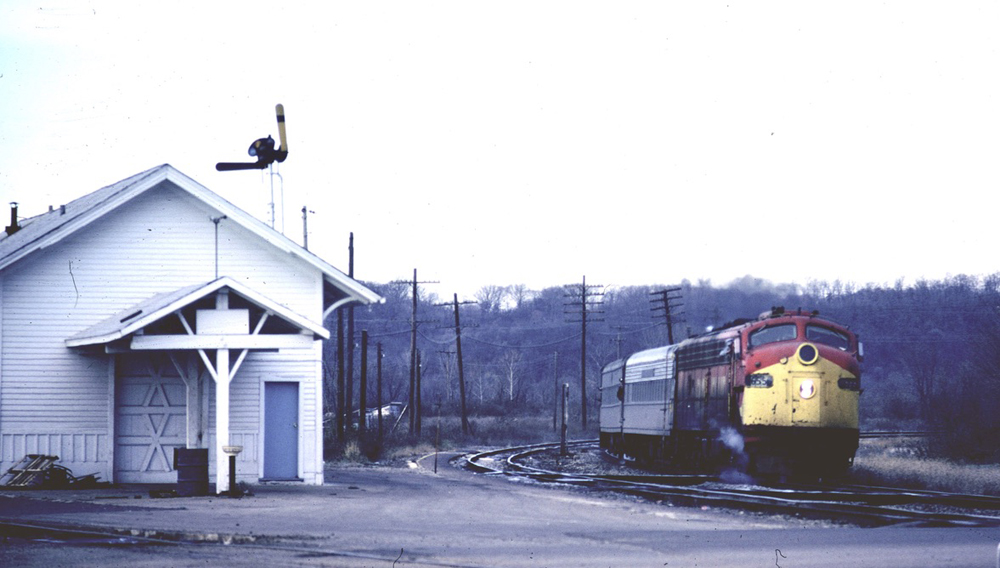
PEORIA, Ill. — Officials from Peoria and nearby communities have announced results of a feasibility study for a Chicago-Peoria passenger rail corridor over former Chicago, Rock Island & Pacific tracks that last saw passenger trains in 1978.
The clear intent of last week’s announcement is to compete for $1.8 billion in the Federal Railroad Administration’s recently-announced Corridor Identification and Development Program [see “FRA unveils Corridor ID …,” Trains News Wire, May 17, 2022]. Corridors selected by the end of 2022 will be eligible to apply for $36 billion of Bipartisan Infrastructure Law funding.
Schedules, improvements proposed
The report, prepared by consultant Patrick Engineering, itemizes $2.5 billion worth of infrastructure investments on rails west of Joliet, Ill., now operated by CSX Transportation, regional Iowa Interstate, and short line Tazewell & Peoria. Those investments are detailed on page 18 of the report.
(Story continues below illustration)
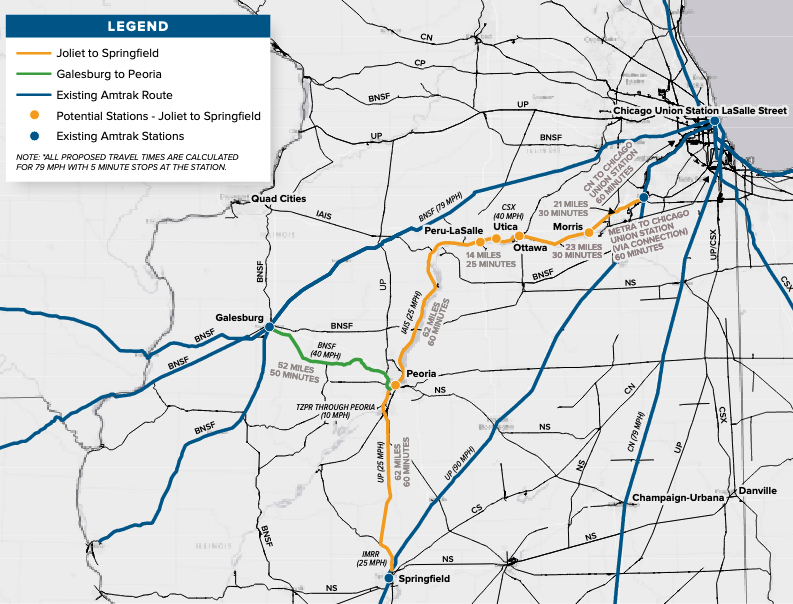
Improvements purportedly would allow five daily round trips at speeds reaching 79 mph on track now ranging from Class 1 (15 mph maximum) to Class 3 (59 mph). The proposed enhancements include mainline rehabilitation and construction; three 3-mile sidings on what is now a single-track railroad; positive train control; and upgrades to 110 public and 104 private grade crossings. Host railroads were not consulted for this “high level of conceptual study.”
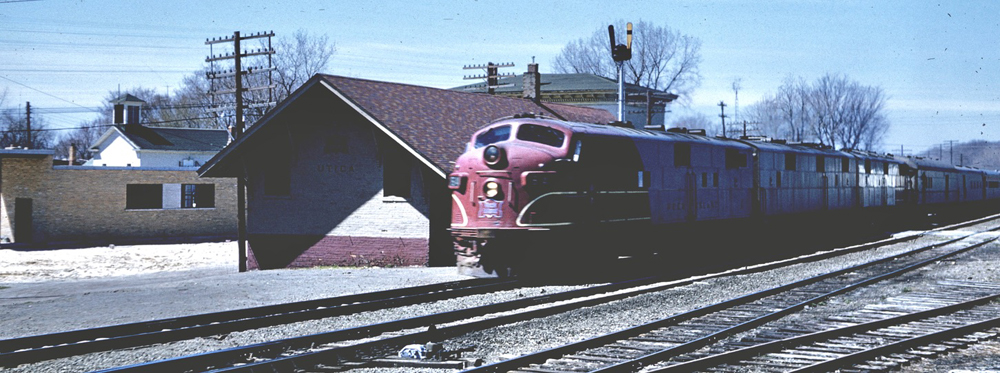
On page 12, the document lists proposed schedules with five intermediate stops and a proposed running time of 2 hours, 27 minutes for the 161-mile Chicago-Peoria route. In 1950, Rock Island’s fastest Peoria Rockets took 2 hours, 35 minutes. Those schedules were lengthened to 3 hours, 10 minutes by the mid-1960s, 3:25 by 1970, and more than four hours over bad track before a single round trip was discontinued on Dec. 31, 1978.
The study’s timetable and string graph require four sets of equipment to execute, though the cost-estimate table lists 10 trainsets for $234 million without further explanation.
Initiative anticipated federal funding
When it became evident that rail infrastructure funding might be available, a steering committee of the region’s civic leaders and federal and state politicians was established in August 2021 that commissioned the Illinois Department of Transportation to fund the study. It is not clear how much money each party contributed or how involved IDOT was in evaluating the report.
One of the committee’s requirements was that Amtrak would be the operator and the corridor must serve Chicago Union Station, but the route between Joliet and Chicago was not specified. As a result, costs of any improvements Canadian National (Amtrak’s current Chicago-St. Louis route) or Metra (the former Rock Island) might require to handle 10 additional passenger trains were not included.
The report does suggest on page 10, though, how new tracks might facilitate entry to Union Station. A CSX-CN connection at Joliet would require a looping connection through or around the Will County Correctional Center. If the Metra route is chosen, Norfolk Southern’s ex-Chicago Junction track across the Dan Ryan Expressway at 39th Street would be utilized by adding a west-to-north track connection to the Amtrak main line. The diagrams are listed as a “concept for discussion, not construction.”
Many steps still remain
More than a year after the demise of Rock Island service, Illinois and Amtrak launched the Chicago-East Peoria Prairie Marksman on Aug. 9, 1980. This utilized a Chenoa, Ill., connection with the Toledo, Peoria & Western from Amtrak’s Chicago-St. Louis route.
The daily round trip, inbound in the morning and outbound in the late afternoon on a 3½ hour schedule, lasted only until Oct. 4, 1981, when it succumbed to low ridership and Reagan-era Amtrak budget cuts.
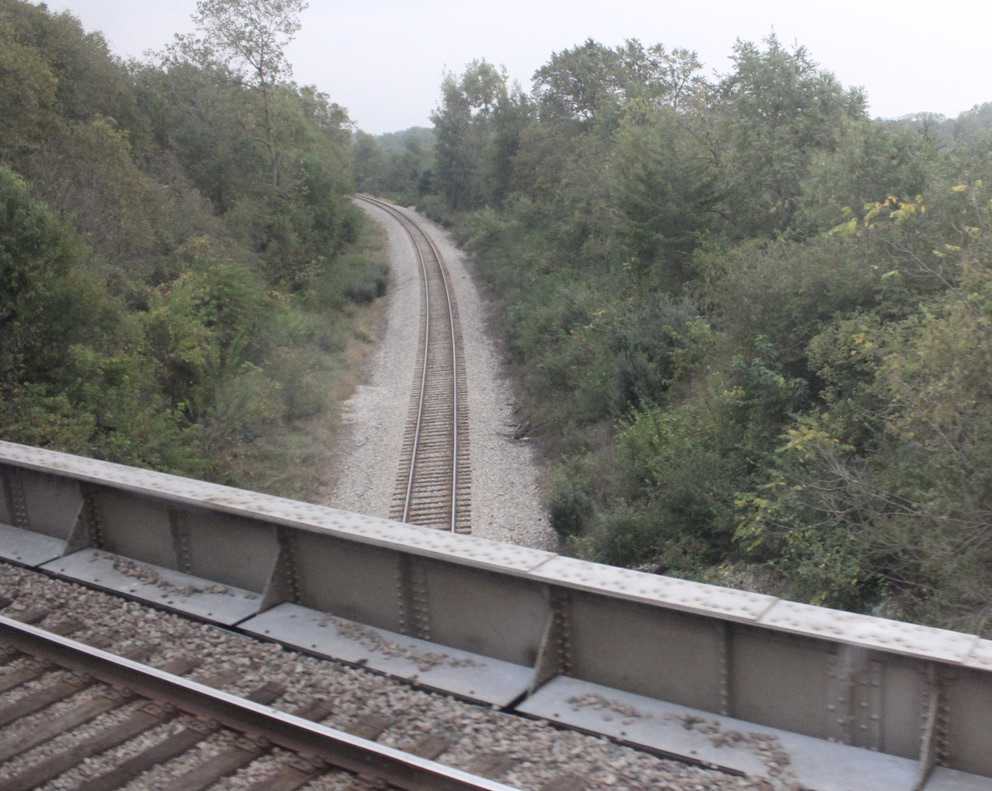
The report notes that since 2003 there have been a series of proposals and feasibility studies to serve Peoria and stations along the former Rock Island route. The latest version provides research attempting to demonstrate ridership potential, based on population in the area and favorable responses to a survey. That information is one of the elements required by the FRA’s competitive Corridor Identification and Development Program. But if the applicants are successful, environmental and more detailed operating analyses must follow before construction money is allocated.
Even then, obstacles remain. Federal grants from a 2010 federal stimulus package have been in place more than a decade for a proposed Chicago-Quad Cities Amtrak corridor, yet the Illinois Department of Transportation and Iowa Interstate have yet to reach agreement on construction and operating terms. There is also no evidence that engineering plans have progressed for a connection between the BNSF Chicago-Galesburg main line and the regional operator at Wyanet, Ill.
Ray LaHood, U.S. Transportation Secretary under President Barack Obama who championed passenger rail investment and was previously a congressman representing the region, spoke at a news conference Thursday. The Peoria Journal Star reported that La Hood said “the stars have aligned properly” for the new service. If their corridor is selected by the FRA, proponents of the Chicago-Peoria route will have a long road ahead before any trains begin running.






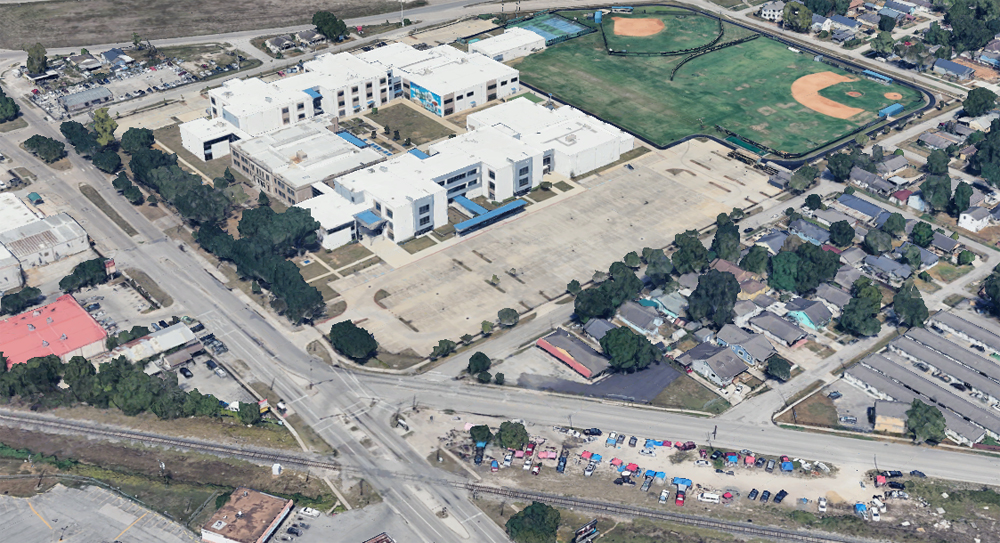
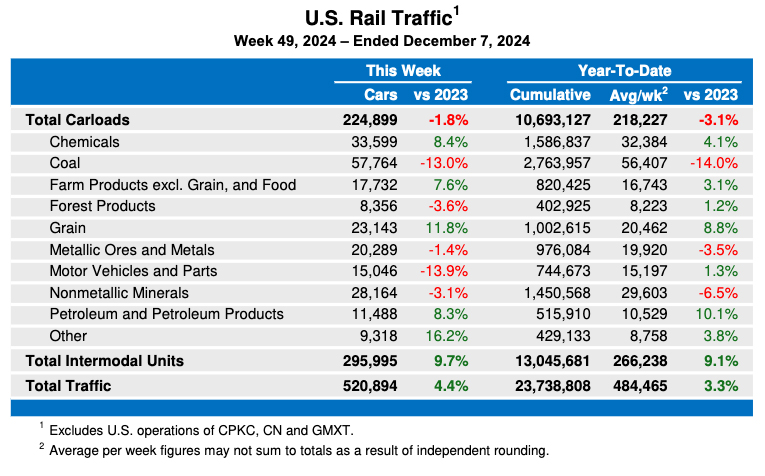
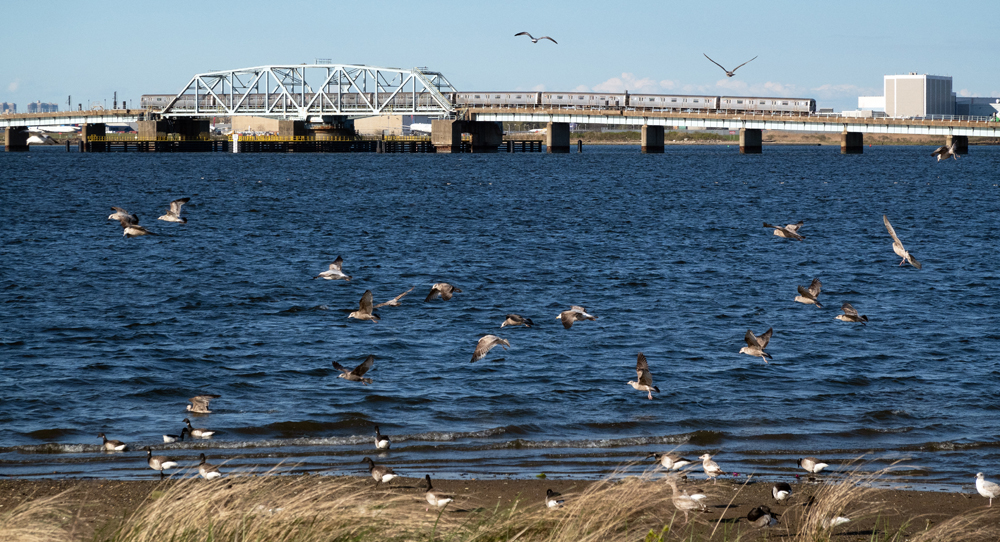
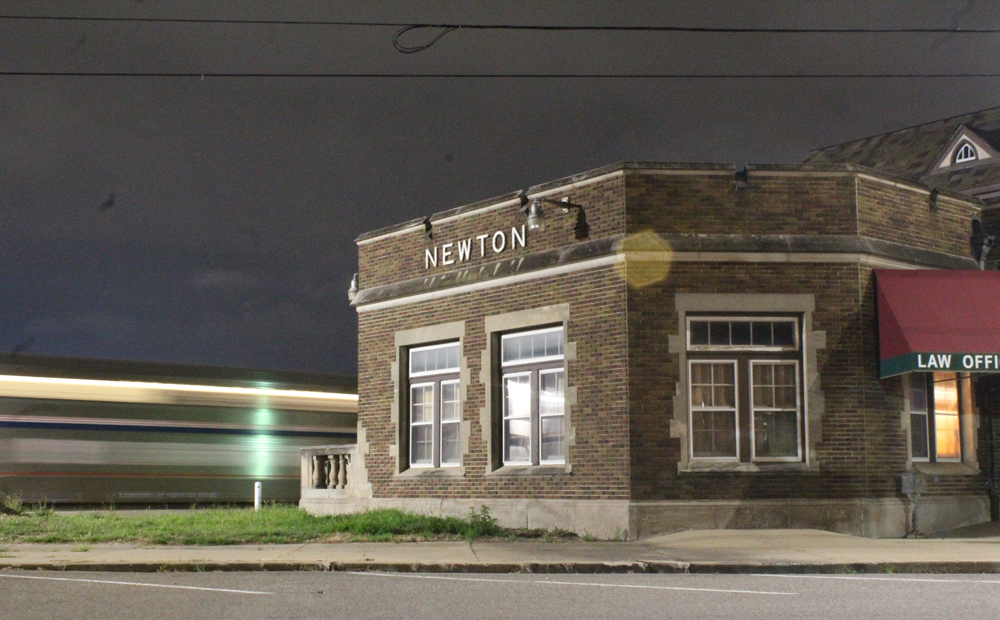




Bus to a train, according to Google Maps.
AFAIK, there isn’t even Bus service between Peoria and Chicago.
Peoria is the third largest city in Illinois and has a large metropolitan area. But from a passenger rail aspect it has always been hampered by not being on a railroad main line. It has to this day many branch and regional lines, but no mains. The closest to a main was the Rock Island’s branch from Bureau, the route of the Peoria Rocket. The Rock’s Peoria line had automatic block signaling which allowed passenger train speeds. It was always the only way to get to Chicago from Peoria.
Now this proposal to spend a lot of money to resurrect the Rock Island trackage has some potential. The failed 1980-81 Prairie Marksman died because of its route. The station was across the river in East Peoria, and the slow Toledo, Peoria & Western tracks to Chenoa put a big crimp in the schedule.
There will be much competition for this bonanza of federal money. It will be up to the state of Illinois to decide how to spend its share. Chicago-Carbondale needs its second train back. The Quad Cities and Rockford also want passenger service. Let the lobbying begin.
Sorry for posting this twice. I was trying to correct my typing error.
Peoria is actually 8th largest city. Unless you are looking at MSA.
Of the top ten in population in Illinois, only 2 don’t have Amtrak service.
Rockford and Peoria.
Peoria is the third largest city in Illinois and has a large metropolitan area. But from a passenger rail aspect it has always been hampered by not being on a railroad main line. It has to this day many branch and regional lines, but no mains. The closest to a main was the Rock Island’s branch from Bureau, the route of the Peoria Rocket. The Rock’s Peoria line had automatic block signaling which allowed passenger train speeds. It was always the only way to get to Chicago from Peoria.
Now this proposal to spend a lot of money to resurrect the Rock Island trackage has some potential. The failed 1980-81 Prairie Marksman died because of its route. The station was across the river in East Peoria, and the slow Toledo, Peoria & Western tracks to Chenoa put a big crimp in the schedule.
There will be much competition for this bonanza of federal money. It will be up to the state of Illinois to decide how to spend its share. Chicago-Carbondale needs its second train back. The Quad Cities and Rockford also want passenger service. Let thebying begin.
This is just another regional service Illinois wants Amtrak to help fund. The recent increase in transportation taxes in Illinois (more than doubled in past 10 years) is making all the politicians salivate on new services.
Peoria’s population has been declining since 1960 with only 1 bump in 1970 for when Caterpillar consolidated. But even now they have announced they are moving their HQ to Texas. Peoria has closed one of their high schools due to inadequate enrollment. Peoria workers are moving to Morton or Canton to live. 40% of the labor south of Peoria comes from either Canton, Pekin or Morton.
I will add as reasonable successful corridors the Los Angeles San Diego Surfliners and the Seattle Portland Cascades. A lot has to do with I-5 becoming parking lots in those area especially LAX-SAN.
As stated in the article, the point of proposal was to get on the FTA funding list. If they are awarded some funding, they can get more detailed operational analytics as connection details firm up. Cost estimates should also get more refined at the next stage. The finished project very often doesn’t resemble the proposal when federal funds get involved.
Speaking of Illinois state politics, the LaHood you need to convince is Ray’s son Darren, a very conservative Republican now representing the Peoria District. The “corridor” trains to Quincy and Champaign are there largely for the benefit of collect students from the Chicago suburbs (and their parents). Even Republican voters from the suburbs support the state service to the state’s major universities. I have lectured at U of I several times and the train is a really great way to get there. The problem is the lousy time keeping on CN. In winter you take your life in your own hands if you try to drive down I-57 to Champaign or Carbondale.
Perhaps Illinois should focus on beefing up the Chicago to Carbondale corridor. 391/392 continue to be annulled for Lord knows how long. Illinois Central ran this as a successful corridor. Put back in the second main, put the ATS back in and work with Tennessee to extend 391/392 to Memphis
Agree, I would take it one step further and add another daily City of New Orleans service but have it routed through St Louis on Texas Eagle route and then via back to Memphis by carbondale and or maybe via Poplar Bluff, AK down to Mempis. This could possibly setup a 3rd daily River Runner with service extended into Illinois connecting at Carbondale or extending to Popluar Bluff, AK
..
Someone with better understanding of trackage and connections could note if it is possible to do either
I’ll second Mr. Lustig’s comments regarding capacity restoration CHI-CDL. What used to frost my butt was Sen. Durban’s occasional beating up on CN for freight train- related delays of the two CDL roundtrips. I’m sure Sen. Durbin has supported spending buckets of his constituents’ $$$ widening various congested roads or segments thereof. But doing the same on a rail line, even one that hosts state-funded Amtrak trains, to “reduce congestion” and eliminate delays? Apparently, he’d rather curse the darkness than light a candle. And what’s with Amtrak and ILDOT that they’re dragging their feet on restoring Nos.391/392? Mr. Ekren has some good ideas too but if we can’t even get the above trains back on, what chance is there for a second CONO?
Makes sense looking at the map, no one is saying it’s being built overnight. Stops in Utica and Ottawa (amazing looking area) will increase tourism in that area as well as Peoria.
You can file this one under “More ideas from politicians seeking reelection that won’t see the light of day.” Politicians seem to believe polls that consultants put out. When asked if they want train service from West Overshoe to East Overshoe people, remembering when their grandmother took them on a “train trip” years ago, respond “yes”. But when their taxes are raised to pay for this new train they rebel, and will they ride it? The number of people who ride intercity trains is less than 1/2 of 1% so the answer is no.
Ray LaHood, a member of the GOP, is a pretty smart cookie when it comes to these matters in Illinois. I don’t think he would get behind it if it were to be a failure or just a posing moment.
After reading the article my reaction is this: Yeah, good luck and all that.
Of the existing Chicago corridors, which ones really work? By that I mean multiple daily round trips (3X daily minimum) at good speeds, reliable timekeeping, and decent patronage. Obviously the Hiawatha is a huge success, in my mind Amtrak’s only really good corridor service between NEC and California. To be generous, the Michigan trains. Maybe the Springfield – St. Louis corridor. Can anyone name others? Fifty-one years of Amtrak hasn’t made corridors like Chicago – Champaign sing in good melody. How is this new proposal viable?
State governments like to propose trains between city pairs within state boundaries. Fair enough, but making it work is something else. In my own state there’s a heck of a lot of travel between Milwaukee and Madison. No one has come up with a viable way to connect the two by rail. Ditto, Milwaukee to Appleton – Green Bay.
There are huge travel markets at cities like Nashville, Denver, Atlanta and many others. All of them with zero corridor service and no realistic proposals.
Think Charles pretty much nails it for MIdwest and if this is really a good way to spend the rail funds, infrastructure dollars. I can see the plus side to make the investments on Chicago Union Station and more freight & passenger rail, traffic separation in the Chicago area followed with investments improving & strengthening rail corridors such Chicago-Milwaukee, Chicago-St. Louis (dismal last mile speeds St. Louis Metro East), or Chicago-Detroit which will help strengthen & add benefits to Long Distance trains such as Empire or as a noted in the another post, Texas Eagle.
..